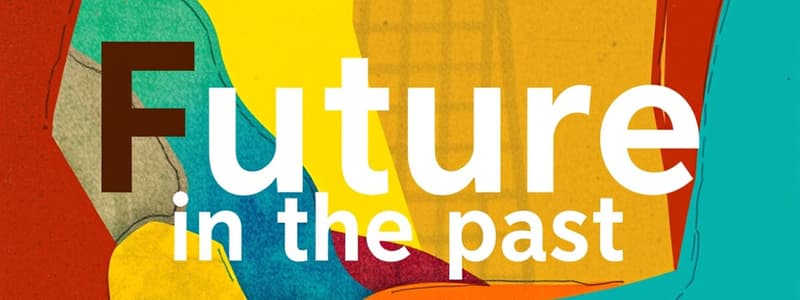Podcast
Questions and Answers
What does the future in the past structure 'was/were going to + base form of the verb' imply?
What does the future in the past structure 'was/were going to + base form of the verb' imply?
- A plan or intention from the past that was fulfilled.
- An intention or plan that existed in the past but may not have happened. (correct)
- An obligation that was strictly enforced.
- A promise that has already been completed.
Which sentence correctly uses 'was/were supposed to'?
Which sentence correctly uses 'was/were supposed to'?
- I am supposed to go to the store tomorrow.
- He was supposed to call her after dinner.
- They were supposed to have finished the homework.
- She was supposed to attend the meeting last week. (correct)
What is the primary use of the 'was/were to + base form of the verb' structure?
What is the primary use of the 'was/were to + base form of the verb' structure?
- To indicate a planned event or action expected to happen in the past. (correct)
- To describe an intention that was indefinitely postponed.
- To express a hypothetical future situation.
- To narrate a current obligation.
How do future in the past structures assist in storytelling?
How do future in the past structures assist in storytelling?
Which of the following sentences conveys an unfulfilled obligation using 'was/were supposed to'?
Which of the following sentences conveys an unfulfilled obligation using 'was/were supposed to'?
In which context would you use 'was/were going to'?
In which context would you use 'was/were going to'?
What is a key point to remember about future in the past structures?
What is a key point to remember about future in the past structures?
Which of the following sentences uses 'was to' correctly?
Which of the following sentences uses 'was to' correctly?
Which statement correctly describes the nature of 'was/were going to'?
Which statement correctly describes the nature of 'was/were going to'?
Study Notes
Future in the Past Structures
-
Definition: Refers to a situation where a future action or event is viewed from a past perspective.
-
Common Structures:
-
Was/Were going to + base form of the verb
- Indicates an intention or plan that existed in the past but may not have happened.
- Example: She was going to call you, but she forgot.
-
Was/Were supposed to + base form of the verb
- Suggests an obligation or expectation in the past that may not have been fulfilled.
- Example: They were supposed to meet us at 6 PM.
-
Was/Were to + base form of the verb
- Used for a planned event or action that was expected to happen in the past.
- Example: He was to start his new job last week.
-
-
Usage Notes:
- Often used in storytelling or recounting events to indicate intentions or plans that were made but not realized.
- Helps to clarify timelines and perspectives in the context of the narrative.
-
Examples in Context:
- "I thought I was going to see her yesterday." (Intention in the past)
- "They were supposed to finish the project by last month." (Expectation not met)
- "We were to attend the conference, but it was canceled." (Planned event)
-
Key Points to Remember:
- Future in the past structures emphasize how future plans or expectations were perceived at a previous time.
- The meaning can change based on the context and the specific structure used.
Future in the Past Structures
-
Represents situations where future actions are considered from a past viewpoint.
-
Was/Were going to + base form:
- Signifies an intention or plan in the past that may not have occurred.
- Example: "She was going to call you, but she forgot."
-
Was/Were supposed to + base form:
- Implies a past obligation or expectation that may not have been met.
- Example: "They were supposed to meet us at 6 PM."
-
Was/Were to + base form:
- Indicates a planned event or action anticipated to happen in the past.
- Example: "He was to start his new job last week."
-
Useful in storytelling to highlight unrealized intentions or plans.
-
Clarifies timelines and perspectives, enriching narrative context.
-
Example phrases illustrate meanings:
- "I thought I was going to see her yesterday." (Past intention)
- "They were supposed to finish the project by last month." (Unmet expectation)
- "We were to attend the conference, but it was canceled." (Cancelled plan)
-
Emphasizes how future plans were viewed from a past standpoint.
-
Context and structure significantly influence meaning and interpretation.
Studying That Suits You
Use AI to generate personalized quizzes and flashcards to suit your learning preferences.
Description
Test your understanding of future in the past structures in English. This quiz covers definitions, common structures, and usage notes to evaluate your grasp of these complex grammatical forms. Brush up on your English grammar skills with practical examples!




